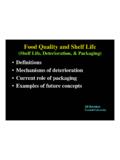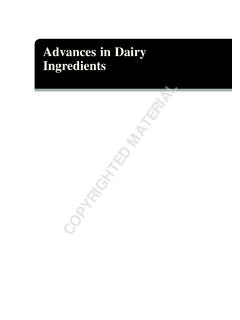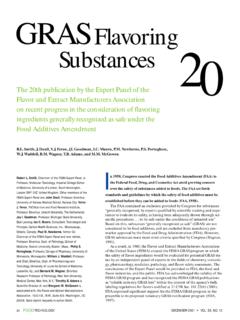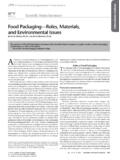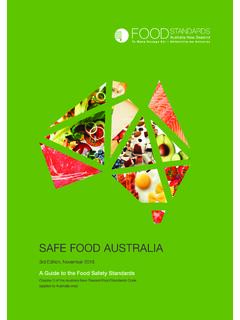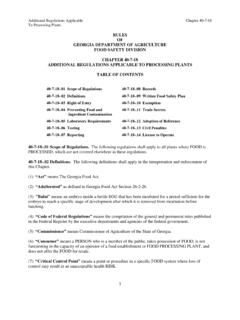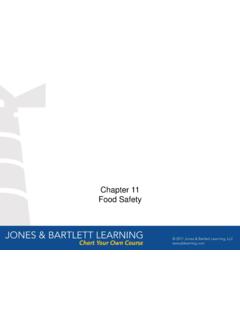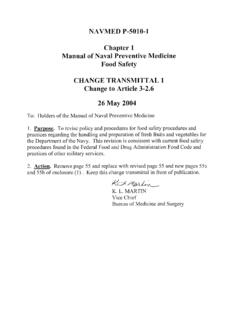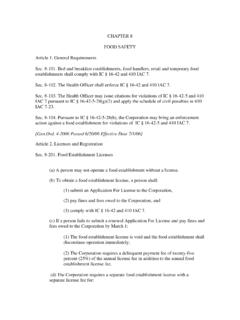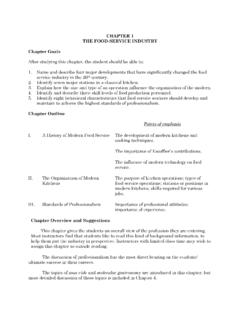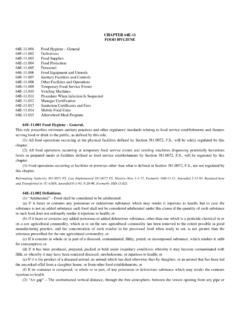Transcription of Chapter 1 Emerging Global Food System Risks and ... - IFT.org
1 Improving Import food safety , First Edition. Edited by Wayne Ellefson, Lorna Zach, and Darryl Sullivan. 2013 John Wiley & Sons, Inc. and the Institute of food Technologists. Published 2013 by John Wiley & Sons, Emerging Global food System Risks and Potential Solutions Shaun Kennedy Chapter 1 Overview The food System is becoming ever more globally integrated, providing a broader array of foods available all year long than ever before. This adaptive, dynamic System does this very rapidly and at very low cost due to the high efficiency of the food and agriculture supply firms and chains. Globalized, just-in-time and cost-optimized supply chains do Overview, 3 Supply Chain Complexity, 4 Increasing Role of Imports, 6 Unusual Sources for Imports, 7 Other Emerging food safety Risks , 10 Economically Motivated Adulteration, 11 Other Emerging Intentional Threats, 13 Potential Solutions, 15 Conclusions, 19 References, 19 310/15/2012 12:28:59 PM10/15/2012 12:28:59 PMCOPYRIGHTED MATERIAL4 Highlighting Key Issuesnot come without concomitant Risks .
2 The lengthening of a supply chain and the inclusion of firms of different scales inherently increases the Risks associated with that supply chain. Sourcing from a wide range of countries also places a reliance on the food protection ( safety and defense) systems of the source country to protect consumers in the country of consumption. One of the challenges of this reliance is that, in some cases, the actual source of the product or ingredient may be difficult for regulators, or in some cases even food - System firms, to discern due to how data are captured and shared in food supply chains. Dynamic import Risks and other Emerging Risks , demonstrate the need for new mitigation strategies to reduce the risk to public health from our globally interdependent food System .
3 Supply Chain Complexity The supply chain for even apparently simple items can be much more complicated than it would appear, especially if it is a multicomponent product where the supply chain of each ingredient or component must be considered as well. Figure provides a simplified characterization of the supply chain for a quick service restaurant sandwich. The 11 basic components of this item make their way from primary production to consumption through a simplified supply chain that includes Figure A simplified characterization of the supply chain for a cheeseburger. (Copyright 2010 National Center for food Protection and Defense.)
4 All rights reserved.) 410/15/2012 12:28:59 PM10/15/2012 12:28:59 PM Global food System Risks 5harvest, storage, production, and retail food service to the consumer, with transportation between each step. Considering this simple System , a contamination that could occur at three, unspecified points in the supply chain for the item represents over 45 000 permutations and combinations of potential contamination scenarios. All of the potential scenarios would have the potential to cause harm, either public health or economic, or in some cases both. Consider, however, that the actual composition of a cheeseburger, for illustration purposes a Big Mac as per McDonald s nutritional information, contains all of the ingredients shown in Figure.
5 Considering the same threat, that the supply chain is contaminated in three locations but no indication of where, means that there are over two million permutations and combinations of potential contamination scenarios. This does not take into account how much more compli-cated it would become with the inclusion of each of the ingredient s supply chains. This is one reason why multicomponent foods, which are a rising source of foodborne illness outbreaks, pose a significant challenge during foodborne illness outbreak epidemiology and food Soy flourBaking sodaWheat glutenCalcium propionateEnzymeMono- and diglyceridesDiacetylTartaric acidEstersEthanolSorbitolPolysorbate 20 Potassium propionateSodium stearoyllactylateCorn starchAmmonium chlorideAmmonium sulfateCalcium peroxideAscorbic acidAzodicarbonamideMilkMilkfatWaterCrea mSodium citrateSaltSodiumphosphateSorbic acidArtificial colorBleached wheat flourMalted barley flourThiamineRiboflavinNiacinFolic acidReduced ironWaterCorn syrupSesame seedsSoybean oilYeastSaltCalcium sulfateCalcium carbonateCalcium silicateDehydrated onionsLettuceUSDA-inspectedbeefSoybean
6 OilPicklesDistilled vinegarWaterEgg yolksHF corn syrupSugarOnion powderCorn syrupSpiceSpice extractivesSaltXanthan gumMustard flourProp. glycolAlginateSodiumBenzoatePotassiumSor bateMustard branGarlic powderHydrolyzedProteinsCaramel colorPaprikaTurmericCalciumDisodiumEDTAG rill seasoningSaltPepperCottonseed oilSoybean oilCheesecultureAcetic acidSoy lecithinEnzymesStarchCucumbersWaterVineg arSaltCalcium chlorideAlumNatural flavoringsPolysorbate 80 Turmeric Figure All of the ingredients in a McDonald s Big Mac. (Graphic copyright 2010 National Center for food Protection and Defense. All rights reserved.) 510/15/2012 12:28:59 PM10/15/2012 12:28:59 PM6 Highlighting Key Issuestrace-back investigations.
7 While this complexity is obviously important for food safety , it is perhaps more important for food defense as there are many more ingredients that are viable candidates for intentional contamination than are likely to be the vehicle for accidental food safety contamination. Imports further complicate existing food protection challenges. While only the producer would have the opportunity to know the probable origin of the ingredients in the finished product, looking at where they could come from is enlightening. Choosing just four of the ingredients from Figure illustrates this point: imports of beef into the United States in 2010 came from 10 countries (Australia, Canada, Chile, Costa Rica, Honduras, Japan, Mexico, New Zealand, Nicaragua, and Uruguay); imports of tomatoes from 12 countries (Belgium, Canada, China, Costa Rica, Dominican Republic, France, Guatemala, Israel, Mexico, Nether-lands, New Zealand, and the United Kingdom).
8 Imports of wheat gluten from 17 countries (Australia, Belgium, Canada, China, France, Germany, India, Italy, Kazakhstan, Lithuania, Netherlands, Poland, Sweden, Switzerland, Taiwan, Thailand, and Turkey); and imports of vinegar from 36 countries (Argentina, Australia, Austria, Belgium, Brazil, Cambodia, Canada, Chile, China, Colombia, Dominican Republic, France, Germany, Greece, Honduras, Hong Kong, Israel, Italy, Japan, Jordan, Korea, Lebanon, Mexico, Monaco, Netherlands, Panama, Peru, Philippines, Poland, Portugal, Serbia, South Africa, Spain, Taiwan, Turkey, and the United Kingdom) (US Department of Agriculture Foreign Agricultural Service, 2008 ).
9 These countries encompass a wide range of food protection System capabilities and challenges. Increasing Role of Imports food and agriculture imports have been rising rapidly, accelerating as early as 2003. In 2003 the total food and agriculture imports to the United States totaled just over $35 billion. In 2010, that increased to nearly $82 billion (US Department of Agriculture, 2010 ). This rate will likely accelerate in the coming years. This is driven by a number of factors, including: increased food and agriculture industries outside the United States; consumer desire for a wide variety of fresh fruits and vegetables; increased consumption of seafood; and many others.
10 While the United States continues to be a net exporter of food and 610/15/2012 12:29:00 PM10/15/2012 12:29:00 PM Global food System Risks 7agriculture, there are more food manufacturing firms registered to produce food for United States consumption in FDA s Bioterrorism Registration Database outside the United States (150 000) than in the United States (130 000). Unusual Sources for Imports The globalization of the food System results in more countries being sources of food products for the United States than ever before. The countries are not always, however, those that you would expect.

